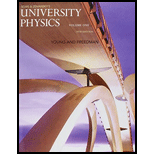
Concept explainers
BIO ULTRASOUND IMAGING. A typical ultrasound transducer used for medical diagnosis produces a beam of ultrasound with a frequency of 1.0 MHz. The beam travels from the transducer through tissue and partially reflects when it encounters different structures in the tissue. The same transducer that produces the ultrasound also detects the reflections. The transducer emits a short pulse of ultrasound and waits to receive the reflected echoes before emitting the next pulse. By measuring the time between the initial pulse and the arrival of the reflected signal, we can use the speed of ultrasound in tissue, 1540 m/s, to determine the distance from the transducer to the structure that produced the reflection.
As the ultrasound beam passes through tissue, the beam is attenuated through absorption. Thus deeper structures return weaker echoes. A typical attenuation in tissue is −100 dB/m · MHz; in bone it is −500 dB/m · MHz. In determining attenuation, we take the reference intensity to be the intensity produced by the transducer.
16.77 If the deepest structure you wish to image is 10.0 cm from the transducer, what is the maximum number of pulses per second that can be emitted? (a) 3850; (b) 7700; (c) 15,400; (d) 1,000,000.
16.78 After a beam passes through 10 cm of tissue, what is the beam’s intensity as a fraction of its initial intensity from the transducer? (a) 1 × 10−11; (b) 0.001; (c) 0.01; (d) 0.1.
16.79 Because the speed of ultrasound in bone is about twice the speed in soft tissue, the distance to a structure that lies beyond a bone can be measured incorrectly. If a beam passes through 4 cm of tissue, then 2 cm of bone, and then another 1 cm of tissue before echoing off a cyst and returning to the transducer, what is the difference between the true distance to the cyst and the distance that is measured by assuming the speed is always 1540 m/s? Compared with the measured distance, the structure is actually (a) 1 cm farther; (b) 2 cm farther; (c) 1 cm closer; (d) 2 cm closer.
Want to see the full answer?
Check out a sample textbook solution
Chapter 16 Solutions
University Physics with Modern Physics, Volume 1 (Chs. 1-20) (14th Edition)
Additional Science Textbook Solutions
Applications and Investigations in Earth Science (9th Edition)
Organic Chemistry (8th Edition)
Campbell Biology (11th Edition)
Chemistry: Structure and Properties (2nd Edition)
Human Biology: Concepts and Current Issues (8th Edition)
Campbell Essential Biology with Physiology (5th Edition)
- What is the period of a rock of mass 2.0kg tied to the end of a spring 0.625m long string that hangs in a doorway and has an elastic constant of 40N/m?arrow_forwardGive an example of friction speeding up an object.arrow_forwardWhich is the higher temperature? (Assume temperatures to be exact numbers.) (a) 272°C or 272°F? 272°C 272°F They are the same temperature. (b) 200°C or 368°F? 200°C 368°F They are the same temperature.arrow_forward
- What is the direction of a force vector given by ~v = −6Nˆi − 8Nˆj?arrow_forwardWhat can be said of the position vector of an object far from any influences on its motion?arrow_forward་ Consider a ball sliding down a ramp as shown above. The ball is already in motion at the position 1. Which direction best approximates the direction of acceleration vector a when the object is at position 2?arrow_forward
 Physics for Scientists and Engineers, Technology ...PhysicsISBN:9781305116399Author:Raymond A. Serway, John W. JewettPublisher:Cengage Learning
Physics for Scientists and Engineers, Technology ...PhysicsISBN:9781305116399Author:Raymond A. Serway, John W. JewettPublisher:Cengage Learning College PhysicsPhysicsISBN:9781305952300Author:Raymond A. Serway, Chris VuillePublisher:Cengage Learning
College PhysicsPhysicsISBN:9781305952300Author:Raymond A. Serway, Chris VuillePublisher:Cengage Learning College PhysicsPhysicsISBN:9781285737027Author:Raymond A. Serway, Chris VuillePublisher:Cengage Learning
College PhysicsPhysicsISBN:9781285737027Author:Raymond A. Serway, Chris VuillePublisher:Cengage Learning Principles of Physics: A Calculus-Based TextPhysicsISBN:9781133104261Author:Raymond A. Serway, John W. JewettPublisher:Cengage Learning
Principles of Physics: A Calculus-Based TextPhysicsISBN:9781133104261Author:Raymond A. Serway, John W. JewettPublisher:Cengage Learning Physics for Scientists and Engineers: Foundations...PhysicsISBN:9781133939146Author:Katz, Debora M.Publisher:Cengage Learning
Physics for Scientists and Engineers: Foundations...PhysicsISBN:9781133939146Author:Katz, Debora M.Publisher:Cengage Learning Glencoe Physics: Principles and Problems, Student...PhysicsISBN:9780078807213Author:Paul W. ZitzewitzPublisher:Glencoe/McGraw-Hill
Glencoe Physics: Principles and Problems, Student...PhysicsISBN:9780078807213Author:Paul W. ZitzewitzPublisher:Glencoe/McGraw-Hill





